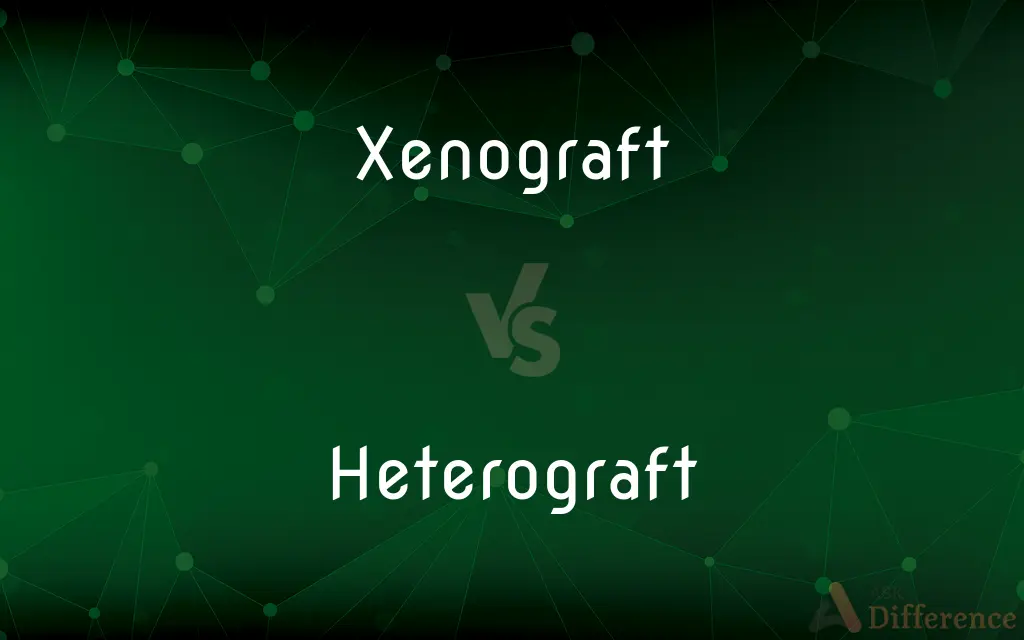Xenograft vs. Heterograft — What's the Difference?
By Maham Liaqat & Fiza Rafique — Updated on April 3, 2024
Xenograft and heterograft both refer to the transplantation of tissue between different species, yet they are different terms for the same concept.

Difference Between Xenograft and Heterograft
Table of Contents
ADVERTISEMENT
Key Differences
Xenograft and heterograft are two terms that often confuse many due to their similar meanings in the context of medical and biological sciences. Both terms refer to the process of transplanting tissues or organs from one species to another. For example, when tissue from a pig is transplanted into a human, it is known as a xenograft or a heterograft. The primary distinction lies not in their definitions but in the preference of usage within different scientific communities.
While "xenograft" is more commonly used in scientific literature and research, "heterograft" might be found in older texts or used by certain professionals within the field. This reflects not a difference in meaning but rather in linguistic preference. "Xeno-" originates from the Greek word for "foreign," implying the foreign nature of the graft to the host species. On the other hand, "hetero-" also derives from Greek, meaning "different," which similarly conveys the concept of difference but without the specific connotation of foreignness.
In practical applications, both xenografts and heterografts are crucial for medical research, especially in the study of disease processes and the testing of new treatments. These grafts offer a way to observe how human diseases progress in non-human systems and how human tissues react to treatments in a living organism without initial human trials. Despite their usefulness, both types of grafts face significant challenges, such as rejection by the host's immune system, which highlights their foreign or different origin, reinforcing the concepts embedded in their names.
The choice between "xenograft" and "heterograft" may also be influenced by the specific field of study. In oncology, for example, "xenograft" is frequently used to describe the transplantation of human tumor tissues into mice to study cancer behaviors and treatments. This specificity in usage underscores the importance of context when choosing terminology in scientific discourse.
Understanding the similarities and differences between xenograft and heterograft is essential for comprehending broader concepts in transplantation biology and medical research. While their meanings overlap significantly, the nuances in their usage and historical context provide insight into how scientific terminology evolves and adapts over time.
ADVERTISEMENT
Comparison Chart
Definition
Transplantation of tissues or organs between different species.
Same as xenograft.
Common Usage
Predominantly used in modern scientific literature and research.
May appear in older texts or less commonly in certain fields.
Etymology
Derived from Greek "xeno-", meaning "foreign".
Derived from Greek "hetero-", meaning "different".
Application
Commonly used in medical research, especially in oncology.
Usage varies, but less specified by field.
Immunological Challenges
Both face host immune system rejection due to the foreign nature of the graft.
Same as xenograft.
Compare with Definitions
Xenograft
Transplantation between different species.
The xenograft study involved transplanting human cancer cells into mice.
Heterograft
Less commonly used.
Heterograft is less commonly used than xenograft in contemporary research.
Xenograft
Faces immune rejection.
The main challenge with xenografts is the immune response from the host.
Heterograft
Another term for xenograft.
Heterograft procedures involve species-to-species tissue transplants.
Xenograft
Derived from "foreign".
The term xenograft emphasizes the foreign origin of the transplanted tissue.
Heterograft
Used interchangeably with xenograft.
In some texts, heterograft and xenograft mean the same thing.
Xenograft
Used in medical research.
Xenograft models are crucial for testing new cancer treatments.
Heterograft
Derived from "different".
Heterograft comes from the Greek for different, indicating the transplant's distinct origin.
Xenograft
Applies to tissue and organ transplants.
Xenograft techniques have evolved to improve transplantation success rates.
Heterograft
Also faces immune rejection.
Heterografts are often rejected by the host's immune system.
Xenograft
A tissue graft or organ transplant from a donor of a different species from the recipient.
Heterograft
Another term for xenograft
Xenograft
A tissue or organ graft between individuals of different species. Also called heterograft.
Heterograft
See xenograft.
Xenograft
A tissue graft taken from a species different from that of the recipient.
Heterograft
Synonym of xenograft.
Xenograft
To heterograft.
Heterograft
To perform a tissue graft using tissue taken from a species different from that of the recipient.
Xenograft
Tissue from an animal of one species used as a temporary graft (as in cases of severe burns) on an individual of another species
Heterograft
Tissue from an animal of one species used as a temporary graft (as in cases of severe burns) on an individual of another species
Common Curiosities
What is a xenograft?
A xenograft is the transplantation of tissues or organs between different species.
What challenges do xenografts face?
The primary challenge is rejection by the host's immune system, recognizing the transplant as foreign.
Are xenografts and heterografts used in human medicine?
They are primarily used in research settings due to the high risk of immune rejection in clinical applications.
How does a heterograft differ from a xenograft?
Heterograft is another term for xenograft; they refer to the same medical procedure.
Why are xenografts important in research?
Xenografts allow researchers to study diseases and test treatments in live organisms without initial human trials.
Is there a difference in usage between xenograft and heterograft?
Yes, xenograft is more commonly used in contemporary scientific literature, while heterograft might appear in older texts or less frequently.
What does "xeno-" mean in xenograft?
"Xeno-" is derived from the Greek word for "foreign," indicating the foreign nature of the transplant to the host.
Why might someone choose to use the term heterograft over xenograft?
Preference for the term heterograft may be influenced by historical usage or specific scientific community conventions.
Can xenografts be used for organ transplantation in humans?
While research is ongoing, xenografts for organ transplantation in humans face significant ethical and immunological challenges.
Can xenografts be used in cancer research?
Yes, xenografts are especially useful in oncology for studying tumor behavior and testing new cancer treatments.
What does "hetero-" mean in heterograft?
"Hetero-" comes from Greek, meaning "different," which also conveys the concept of the transplant being different from the host.
How do researchers overcome the challenge of immune rejection in xenografts?
Researchers use immunodeficient animals or develop techniques to reduce the host immune response.
How does the immune system recognize xenografts as foreign?
The immune system recognizes proteins on the surface of the transplanted tissue that are not present in the host species.
What advancements have been made in xenograft transplantation?
Advances include the development of immunodeficient mouse models and genetic engineering to reduce rejection.
What is the future of xenograft research?
The future includes improving techniques to reduce rejection and expanding the use of xenografts in personalized medicine research.
Share Your Discovery

Previous Comparison
Unorganized vs. Disorganized
Next Comparison
Podium vs. StageAuthor Spotlight
Written by
Maham LiaqatCo-written by
Fiza RafiqueFiza Rafique is a skilled content writer at AskDifference.com, where she meticulously refines and enhances written pieces. Drawing from her vast editorial expertise, Fiza ensures clarity, accuracy, and precision in every article. Passionate about language, she continually seeks to elevate the quality of content for readers worldwide.
















































